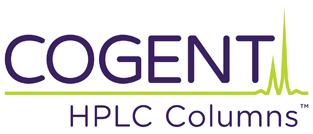In Aqueous Normal Phase HPLC (ANP), perhaps the most effective and simplest way to modify selectivity is to adjust your mobile phase to a different pH.
The ionization state of the analytes and/or stationary phase is believed to play a critical part in the ANP retention mechanism, so a different pH can often produce significant changes in chromatography. In obtaining the desired pH, be sure to use a mobile phase additive that is compatible with both the stationary phase and your system; phosphates, for example, should not be used in LC-MS methods.
Common additives suitable for most applications are 0.1% formic or acetic acid and 10mM ammonium acetate or formate. The Cogent™ HPLC columns have specifications for suitable operating pH ranges. See pH specifications for the Diamond Hydride™ column and its limitations.
It has been shown that different solvents used for the organic component in ANP methods (e.g. acetone vs. acetonitrile) can produce notably different retention of some analytes. Data suggests that a combination of the two could be a useful method development tool in optimizing selectivity or retention. For example, a peak pair may co-elute using acetone but be well-resolved with acetonitrile; the inverse may occur for another peak pair. Using a combination of the two may be a possibility to obtain a total separation of all the peaks in this case.


